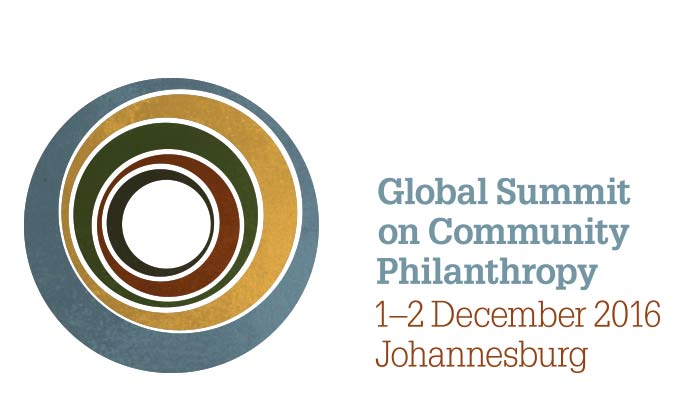Why a Global Summit?
A lot can change in a decade. In December 2004, a gathering in chilly Berlin marked an important moment for the global community foundation movement. 162 people – practitioners, funders, researchers – from over 30 countries came together for the first global meeting on the state of the field. In December 2016, it will be exactly twelve years since Berlin that a follow-up meeting – similarly global in nature – will be held.
Back in 2004, Central and Eastern Europe represented a hot-bed of community foundation development following the dramatic political, social and economic changes that followed the demise of the Soviet Union. There were community foundations in other parts of the world, yes, but in far fewer numbers. It is perhaps fitting therefore, that the Global Summit on Community Philanthropy – to be held on 1 - 2 December 2016 – will be taking place in Johannesburg, South Africa, signifying an important and more recent shift in the growth of community philanthropy to include many more countries in the Global South.
There have been many other developments in the last decade too, both in terms of how and where the field has developed and the backdrop against which these developments are taking place.
Increased numbers: Numbers alone aren’t everything, but it is worth noting that the grand total of community foundations noted in 2004 was 1,175. The number listed today on the Community Foundation Atlas is 1,838 and that is probably a rather conservative estimate.
Evolving definitions, community foundations / community philanthropy: The “community foundation” identity is well-established in certain parts of the world, where civil society is more developed and organized – and where specific groups mean a more targeted set of supports around shared issues. However, in recent years there has been an important shift from a narrower definitional understanding of what defines a “community foundation”, to a broader, more inclusive and perhaps slightly messier idea of a “community philanthropy field.” This “field” is highly diverse, and includes community foundations, grassroots grantmakers, women’s funds, environmental funds etc. all of which share certain characteristics (that include building assets, capacities and trust) and all of which are distinct from both private donor institutions and regular, service delivery or issue-focused types of NGOs.
Emerging practice: Community philanthropy – with its emphasis on strengthening communities through grants and technical support on the one hand, and on harnessing and building different kinds of local assets on the other – offers both a new conceptual space as well as new models of practice. These include tools like community-level decision-making around the allocation of grant resources, promoting and valuing local giving and other kinds of local assets, and innovative financing models such as community or affiliated funds.
New actors, new networks: In the past community philanthropy – as a field and as a practice – has not traditionally been part of mainstream development. The creation of the Global Alliance for Community Philanthropy, which includes a range of private and public sector donors (including, for the first time, USAID) marks an important moment for the field. Also important is the more recent emergence of “Emerging Markets Philanthropy” and the particular relevance of community philanthropy as a strategy for oiling the machinery of effective local NGO sectors and for new approaches to local giving in low-trust environments.
Safeguarding spaces for civil society while rethinking aid: The 2015 CIVICUS State of Civil Society Report highlights concerns regarding the recent assaults on civil society – and in particular, the regulatory spaces in which it operates – in a growing number of countries. These have resulted in reductions in foreign funding, or access to foreign funding for civil society activity, in countries such as India and Russia. The report also notes that, despite efforts to reform how development aid is disbursed, it is still the case that little development aid reaches civil society organizations in target countries, the majority still being channelled through Northern counterparts. There is also an urgent need to address the external Northern bias in disbursement and decision-making around development aid. This has started to move up various multilateral and bilateral aid agendas, providing new opportunities to argue for the role of locally rooted grantmakers / community philanthropy organizations in devolving resources and decision-making to actors that closer to the ground.
New conversations, new issues and linking to other sectors: In recent years, new sets of relationships and partnerships have emerged between community philanthropy and other parts of the development landscape, including international and national development programmes, other parts of civil society, INGOs, local philanthropic sectors, and corporations, to name but a few. Whether it is around community philanthropy in the context of disaster response, as a strategy for facilitating multi-stakeholder development around the benefits derived from mining, new models for sustainability that can support the people-focused programmes of INGOs or strengthening the practice of grassroots grantmaking, the Summit will offer a unique and important opportunity to bring some of these emerging conversations to a broader audience.
Discussions have been underway for some time to hold a Global Summit on Community Philanthropy, which would form part of current efforts to develop the field. Consultative meetings have been held with key stakeholders in the field (practitioners and funders) to invite ideas about the appropriate format and content for such a gathering, which seeks to:
- Link the field more strategically with other parts of the development landscape (international and national development programmes, other parts of civil society, INGOs, local philanthropic actors, and corporations, to name but a few).
- Deepen practice within the field.



